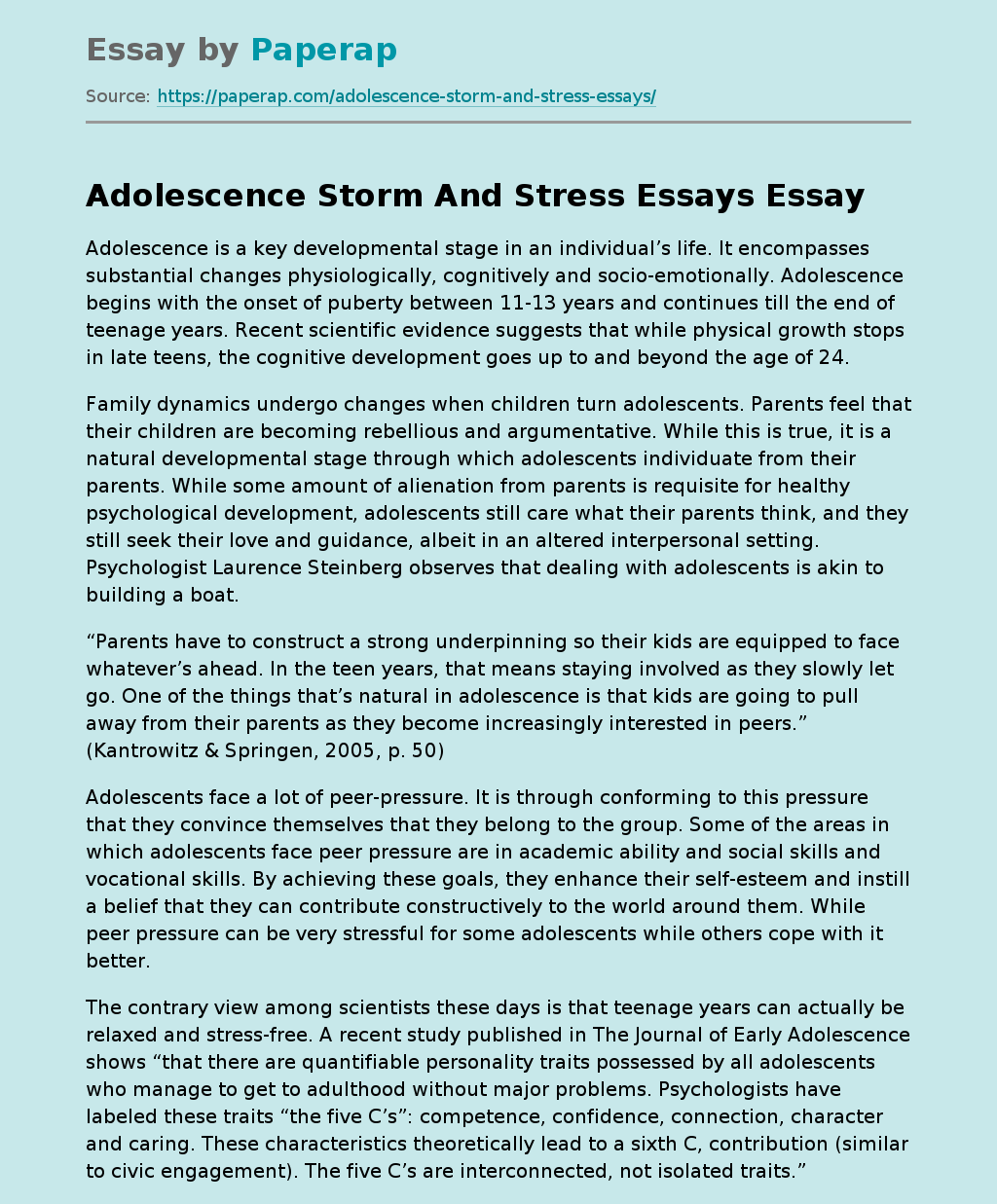Adolescence Storm And Stress Essays
Adolescence is a key developmental stage in an individual’s life. It encompasses substantial changes physiologically, cognitively and socio-emotionally. Adolescence begins with the onset of puberty between 11-13 years and continues till the end of teenage years. Recent scientific evidence suggests that while physical growth stops in late teens, the cognitive development goes up to and beyond the age of 24.
Family dynamics undergo changes when children turn adolescents. Parents feel that their children are becoming rebellious and argumentative. While this is true, it is a natural developmental stage through which adolescents individuate from their parents.
While some amount of alienation from parents is requisite for healthy psychological development, adolescents still care what their parents think, and they still seek their love and guidance, albeit in an altered interpersonal setting. Psychologist Laurence Steinberg observes that dealing with adolescents is akin to building a boat.
“Parents have to construct a strong underpinning so their kids are equipped to face whatever’s ahead. In the teen years, that means staying involved as they slowly let go.
One of the things that’s natural in adolescence is that kids are going to pull away from their parents as they become increasingly interested in peers.” (Kantrowitz & Springen, 2005, p. 50)
Adolescents face a lot of peer-pressure. It is through conforming to this pressure that they convince themselves that they belong to the group. Some of the areas in which adolescents face peer pressure are in academic ability and social skills and vocational skills. By achieving these goals, they enhance their self-esteem and instill a belief that they can contribute constructively to the world around them.
While peer pressure can be very stressful for some adolescents while others cope with it better.
The contrary view among scientists these days is that teenage years can actually be relaxed and stress-free. A recent study published in The Journal of Early Adolescence shows “that there are quantifiable personality traits possessed by all adolescents who manage to get to adulthood without major problems. Psychologists have labeled these traits “the five C’s”: competence, confidence, connection, character and caring. These characteristics theoretically lead to a sixth C, contribution (similar to civic engagement). The five C’s are interconnected, not isolated traits.”
The lengthy period of adolescence in advanced societies today, spanning the entire teenage years, has no historical precedence. For the major part of human civilization, adolescent boys took on work responsibilities and adolescent women got married and entered motherhood. As technology, the standard of living and access to education to both sexes improved over the course of centuries, we now have prolonged adolescence to contend with. In the eras that have gone by, for the vast majority of teenagers, “book learning and formal education were simply unavailable. In this radically different cultural and institutional setting, teens were expected to behave with far greater maturity and to take on adult roles. In response to those expectations, many (indeed almost all) actually did.” In contemporary societies, by assigning only a few serious responsibilities to teens and demanding relatively little of them, we allow certain tendencies to emerge and even actively promote them.
Adolescence is the time of maximum vitality, but it is also full of risk and vulnerability. When a rapidly growing body is paired with an immature and undeveloped mind, they are inclined to experiment with alcohol, drugs and sex. This vulnerability is exploited fully by the capitalist system, where adolescents are bombarded with advertisements for “unhealthy products and lifestyles – tobacco, alcohol, junk food – which doctors compare to an infectious disease epidemic.”
“While puberty catapults adolescents into a period of risky behavior powered by their raging hormones, their brains are ill-equipped to exert control and vulnerable to the effects of activities such as drinking and drug-taking. Scientists say the adolescent brain is handicapped in the rational assessment of risk and prone to “hot cognitions” – decisions influenced by exciting or stressful conditions which adults are better able to resist.”
There is keen interest among teenagers to indulge in sexual activity. The hormonal upsurge that they experience makes it a physiological urge, but at the same time curiosity and boosting self-esteem are also behind it. Unfortunately, this heightened interest in sex among adolescents has made them vulnerable to sexually transmitted infections (STIs), leading to “suspensions (or even arrests) resulting from students sending each other sexually explicit text messages. Another alarming trend is the downward expansion of casual sexual activity from college and university campuses to middle and high school buildings.” (Liace, Nunez, & Luckner, 2011) This is certainly a negative tendency as it is potentially harmful both physically and psychologically. For example, early adolescent sexual activity brings with it the risk of unwanted pregnancy, propensity for depression, etc.
References
- Kantrowitz, B., & Springen, K. (2005, May 16). A Peaceful Adolescence;
- the Teen Years Don’t Have to Be a Time of Family Storm and Stress. Most Kids Do Just Fine, and Now Psychologists Are Finding out Why That Is. Newsweek International, 50. Laurance, J. (2012, April 25). Teenage Plus: The New Adolescence. The Independent (London, England), p. 26. Liace, L. K., Nunez, J. B., & Luckner, A. E. (2011, March/April).
- Casual Sex in Adolescence: Outcomes and Implications for Practice. National Association of School Psychologists. Communique, 39(6), 1+. Wax, A. L. (2012, Summer). An Incomplete View of Adolescence. Issues in Science and Technology, 28(4), 8+.
Adolescence Storm And Stress Essays. (2019, Dec 05). Retrieved from https://paperap.com/adolescence-storm-and-stress-essays/

